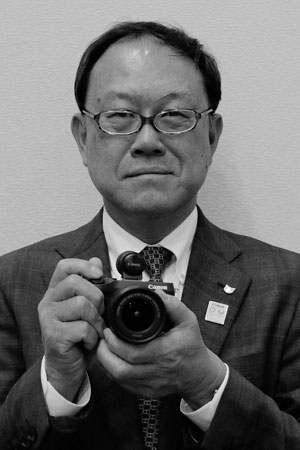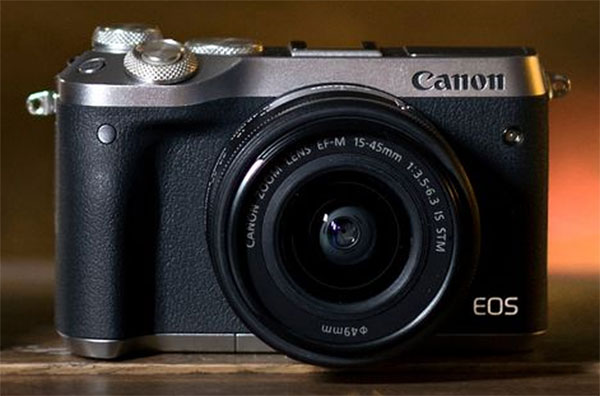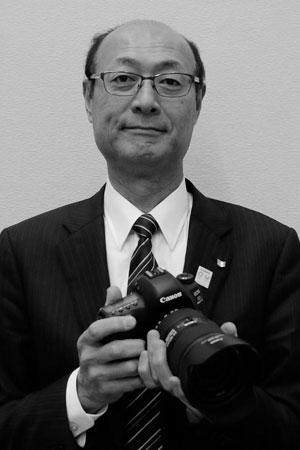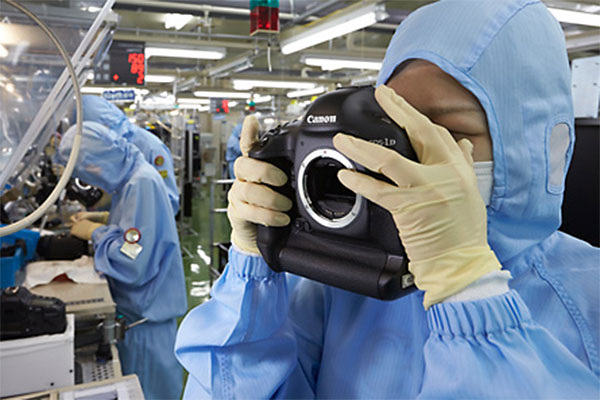Canon Q&A @ CP+ 2017: Canon’s enthusiast mirrorless aspirations, the future of 4K and more
posted Thursday, March 2, 2017 at 7:00 AM EDT

Photography giant Canon is always big news at the annual CP+ tradeshow in its native Japan. Our founder and publisher Dave Etchells is at the show, and had the opportunity to discuss a number of topics with Canon executives at CP+ 2017. Representing Canon were Go Tokura, Executive Officer and Chief Executive of the company's Image Communication Business Operations; Yoshiyuki Mizoguchi, group executive within the ICB Products Group, Image Communication Business Operations; and Goshi Nakamura, Manager; Marketing, Camera and Video Business Planning Div., Imaging Technology & Communication Group, Canon U.S.A. Inc. And while they couldn't discuss the company's future products -- something that's par for the course in executive interviews like these -- both gentlemen nevertheless had plenty of insights to share, especially regarding Canon's view of the mirrorless camera market and its place within it.
The recent Canon EOS M5 and newly-announced EOS M6 both include Dual Pixel CMOS autofocus systems, and Canon enlightened us as to the challenges associated with bringing this technology to new cameras while still maintaining the desired price point. And there are similar challenges regarding the implementation of 4K video, particularly in more affordable cameras, an area in which the company again provided some very interesting insights.
Additional topics of discussion included the dedicated video camera market and the future of the PowerShot line. We even learned which advanced PowerShot cameras are number one and number two in sales in the United States! Will the answer surprise you? Read on to find out...
Dave Etchells/Imaging Resource: Some analysts have noted Canon's relatively slow entry into the mirrorless market and felt that it was over a concern about cannibalizing or reducing existing DSLR sales, but on the other hand there are many competitors moving very strongly in that space. How do you see mirrorless fitting into Canon's overall strategy generally? And are we likely to see more emphasis going forward, or do you view mirrorless as continuing to be more of a niche market rather than DSLR sales?

Group Executive
ICB Products Group
Image Communication Business Operations
Canon Inc.
Yoshiyuki Mizoguchi/Canon Inc.: So in terms of how we look at the mirrorless market, I think there's a regional variance that we can actually point out at the moment. Different regions have different penetrations in mirrorless market share. For example, if you look at Japan, it's a 50/50 [share between DSLR and mirrorless]. And we actually saw the penetration growing, but having said that, in the last couple of years that has sort of settled down into just a 50/50 [split]. So we're looking [at] this as rather than mirrorless taking over or maybe there's a great shift back to SLR, we see that there's a nice sort of a coexistence of the markets, and that's how we see it. And the different markets will have a different breakdown in ratios.
DE: Ah, yes.
YM: As you know, Canon offers both mirrorless and SLR products, and we will continue to do this. We will position those categories in that regard, and we would like to look at the ILC market as a whole to respond to the wide range of demands that are coming in with these two prongs.
But having said that, out of all of our lineup at the moment, I think that the EOS [Kiss] X-series [aka the EOS Rebel series in US markets), it's about really offering a light, small camera, and we're answering that demand. I think that was a broad play for for a number of years, but in the last couple of years with the introduction of the M5 and M6, we are seeing that the EOS series will have more of a role to play, in addition to being small [and] lightweight. There's a greater demand for the mirrorless market, as you can see that Japan is 50/50 at the moment. Other regions are seeing more demand as well. So it's [up to] us to respond to this diversifying demand for the mirrorless market.
DE: As you mentioned the mirrorless market is broadening, and with the EOS M5 Canon is now finally offering a true enthusiast-level mirrorless camera with many features those users demand. But looking at the EF-M lens lineup, there are a wide range of focal lengths available, but they feel much more consumer-focused. We're wondering whether you see higher-end -- if not professional -- more enthusiast-level lenses on the roadmap for the EOS M family?
YM: I won't be able to disclose any sort of future products, so there's not much details that I can provide at the moment, but obviously there's a growing demand for the enthusiast-level cameras. That's why we're seeing this progression of our camera series, and in a similar way we will start to see the strong demand for the lenses as well, for the enthusiast. We are looking at the market demand and seeing what sort of levels that we're seeing, and we will probably be introducing products along with that.

DE: Moving to Dual Pixel autofocus, we were very excited to see that Dual Pixel CMOS AF technology has been implemented in the EOS M5. (And we say that with an exclamation point!)
<laughter>
DE: It's taken a while for this feature to make its way to the EOS M system. Were there any technical challenges or limitations that prevented you from including Dual Pixel on earlier EOS M cameras like the M2 and M3, or was it more a matter of the technology needing to mature to bring costs down?
YM: Dual Pixel CMOS AF was introduced [in the] 70D, but at the time we did have both the points that you mentioned. We had a technical challenge that we had to overcome, as well as the cost implications that it would incur as well. So it was two things that forbade us from introducing the EOS, but luckily we were able to evolve and we were able to advance, and so that's why we were able to introduce it in the M5.
DE: As a result of the maturing of the technology, is Dual Pixel CMOS AF something that will eventually be able to spread across your line? Or will there always be constraints? [Is it the case that it] may get cheaper, but that not including Dual Pixel [will still be] even cheaper, or will you be able to expand Dual Pixel CMOS AF across the full line?
YM: I think there's a great potential for Dual Pixel CMOS AF technology, [both] for the autofocus for mirrorless [cameras] as well as for video. So obviously we do see the great potential in that, and so we will continue to evolve our technical aspects, [so] as to improve the cost aspects as well to be able to introduce it in a wider range of our series. But having said that, will we have on all of our ranges? That seems to be a question that remains.
So for the SLR product, if you try and do mirror-up shooting [in live view mode], I think this Dual Pixel CMOS does really play an important, effective role. So I believe that there's a great potential in this technology as it will be introduced in the Rebel T7i, so there is a great potential for both mirrorless and our SLR products.
DE: Yes. Moving on to video and 4K: From the very beginning with the 5D Mark II, Canon has had enormous success with video, both with DSLRs and with Cinema EOS products. Interestingly, it seems that premium compacts like the G7X and G7X Mark II have been very popular with video creators, especially with vloggers. Was this an expected response to this product line, and how will it influence your plans for the compact market?
YM: So for the premium compacts, we call it the G-series. We are aware that the bloggers and the YouTubers love that video function and are using it quite frequently. So regardless of it being the G series or the Rebel SL1 or the mirrorless, having [a] video function in a camera is a critical part of the camera going forward. I don't think a still shot is enough; we need the video function in the cameras.
And obviously with that there's a growing demand for a higher video quality, so it's about a higher resolution, a better picture, and that will sort of lead us naturally to into the 4K technology. So take the 4K technology: Because of the energy consumption as well as the cost implications, we are only able to introduce this technology at the moment for our high-end models. But having said that, we will continue to improve and advance our technical capabilities so we hope that with the G7X series, that we would like to introduce that, but keeping in mind that we like to complement what [the] G7X will offer as a product rather than harm it. We wanted 4K to be an additional added value to that.

DE: That somewhat answered my next question. I'm curious what your sense is of demand from users for 4K versus HD. I don't know market stats, but my personal sense is that 4K is a check box people want to mark off but, I suspect most people are still just using HD. What is your sense of that?
YM: I think it's as you said, it is good to have a 4K function. But at the same time we need to think of the output aspect of users' environment, their PCs and their TV monitors, does it have a 4K capability? So that's sort of limiting in terms of the possibilities of being able to enjoy the 4K. So as such PCs and TV environment changes and specs improve, I think that will sort of lead into a greater demand for 4K in cameras.
DE: Yes. I agree.

Executive Officer
Chief Executive
Image Communication Business Operations
Canon Inc.
Go Tokura/Canon Inc.: I have said though you have these users who are not so interested in 4K TV; they won't probably be looking into having a 4K camera. But if those users are interested in adopting a 4K TV, for example, at the moment they will be looking for a 4K-possible camera, so there is that difference in the users.
DE: Yeah, people buying new TVs will think to buy cameras also.
GT: So if they are to replace a camera, might as well have a 4K, is sort of the mindset that will probably kick in.
DE: And this is the third question in this area which we also have largely discussed, and it's a question about 4K appearing in lower-end DSLRs. I imagine it's the same answer, that it has to do with cost and power consumption and the amount of user demand. The question I was going to ask you was is if you were considering it for future successors to the 7D or the 6D, but the answer is, "Well, we'll see when we get there and yes."
GT: Yes, you are right.
DE: And this is a general question within your own product line. For the videographers who want 4K -- and I'm thinking more of the people professionally, as opposed to consumers -- do you find that they would tend, despite the higher cost, to go towards your Cinema EOS-series, or are many of them in fact buying the 5D Mark IV or the 1DX Mark II?
GT: I think it would really depend on what sort of situation that the customers will be using the cameras. I think there's a different camera device for a different setting. So in other words they would have one as a main camera, and they would use the other as a [secondary] camera. And also the space that they have in terms of shooting that video will also define which cameras will be more appropriate, so it's a matter of different uses is how we see it. But obviously there is a great variance in the price points as well, so I think it comes down to the cost performance for that user, per se. So in other words, for those videographers who are not as professional, they might actually look for a more affordable choice, which would lead them to the 5D[-series].

DE: Moving back to the PowerShots, your advanced PowerShot camera line has really filled out in the last few years now. You have very diverse cameras: The G1X Mark II, G3X, G5X, G7X Mark II and G9X Mark II. You really have something for everyone. This is not really a question about what's coming, but we're curious what sort of considerations are involved when you plan new models in that? Do you target specific types of users with each model, or are you just trying to hit particular combinations of features and price points?
YM: I think I would have to say that we do look at the user profiles, what the users are looking for, what the customers want, what they're seeking for in a new camera, so it's a user-focused approach to product planning.
DE: Hmm, yes. We're curious if you can offer any insight into which of the G series has proven to be the most popular. We have been amazed by how popular the G7X Mark II is with our readers. It's consistently, week after week after week, the most popular camera on the site. I would expect that's been one of the most successful models, but I'm curious where the other ones fit in.
<laughter>
Goshi Nakamura/Canon U.S.A. Inc.: Based on our sales results, in the U.S. market, the G7X series is always the best selling. Secondly is the G9X [series], but the top model is the G7X [series].
DE: Yes.
YM: This is not [something we have] publicized, but worldwide, we're seeing a similar trend.

DE: Ah, okay. A general question has to do with the Kumamoto quakes and their impact on Canon. It was probably less a factor for you than many companies, because you make your own interchangeable-lens camera sensors. But there's a great deal of manufacturing infrastructure in Kyushu beyond just sensors. To what extent did the Kumamoto earthquake impact Canon's camera business?
YM: So in terms of the interchangeable-lens camera we do have factories in Kyushu, but we're happy to say that there was hardly any impact in terms of the production capabilities.
DE: Ah, very good.
YM: But in terms of the compact size cameras, this is not our factory, but the parts providers' factories that they have. They had a negative impact [which] actually [caused us] to reduce our production capability [by] up to 1 million units for the year, compared to our plan.
DE: Wow, a reduction...
YM: However, after the earthquake, we revised our plan for the year and we are [forecasting] it to be producing about 4 million units, and we are on target to achieve that target.

DE: Good. Okay. In terms of the general market and how the interchangeable lens business works, as far as we're aware the 80D and 5D Mark IV are selling extremely well, so congratulations on your success. How is Canon's ILC business looking overall in terms of unit sales and revenue compared to the previous year? And if you're able to comment, are you still number one in market share?
YM: So first of all, just let me preface by saying that we don't actually announce our sales and profits in terms of a category of the ILC business.
DE: Ah, I see.
YM: But in terms of our market share for the ILC business, we are happy to say that we [have kept] the number one position for a consecutive 14 years.
DE: 14 years, wow. Congratulations! I think that's all the time we have -- we should probably end with that question. I try to control myself, I keep wanting to ask and talk!
<laughter>